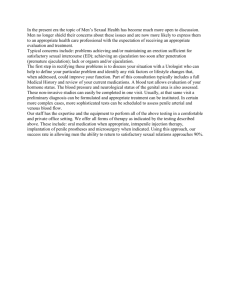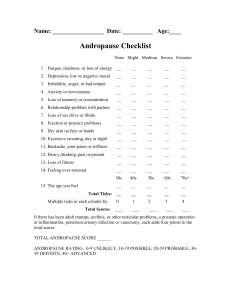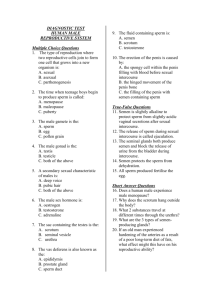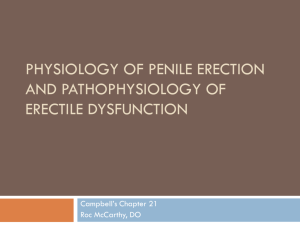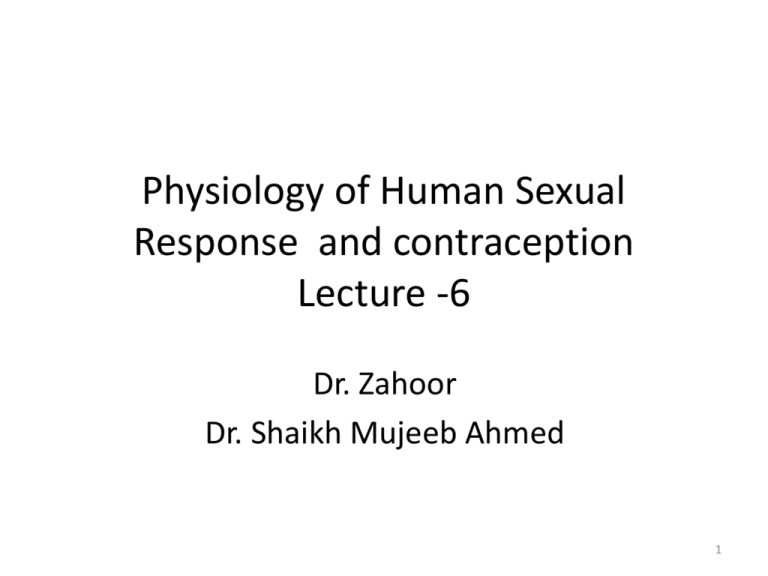
Physiology of Human Sexual
Response and contraception
Lecture -6
Dr. Zahoor
Dr. Shaikh Mujeeb Ahmed
1
SEXUAL ACT
• Union of sperm and ovum requires sexual act
between male and female to deliver semen
containing sperms, in female vagina ( coitus,
copulation ).
2
Components of Male Sexual Act
• Coitus or copulation
• Male sex act involves two components
– Erection: Hardening (increase in length and width)of
normally flaccid penis, as result of increase blood flow in
“erectile tissue” of penis. It is a local vascular response . It
is due to parasympathetic stimulation.
– Ejaculation : forceful expulsion of semen into the
urethra and out of the penis. It is sympathetic response .
3
SEXUAL ACT
• Physiological responses which occur during
sexual act are similar in male and female.
There are FOUR stages
1) Excitement phase
2) Plateau phase
3) Orgasmic phase
4) Resolution phase
4
Sexual Response Cycle in males
• Sexual response is divided into four phases
1. Excitement phase(Arousal).
• Initiated by either physical or psychological
stimuli
• Heightened sexual awareness.
• Vasocongestion(engorgement of sexual
organs)-includes erection
2. Plateau phase:
• Includes intensification of earlier responses
• Characterized by steadily increasing heart rate,
blood pressure, respiratory rate, and increase
muscle tone.
5
Sexual Response Cycle in males
3. Orgasmic phase
• Includes ejaculation, Rhythmic throbbing of
pelvic muscles
• All generalized body responses reaches to peak
– Heavy breathing
– Heart rate upto 180 beats / min
– Marked generalized skeletal muscle contraction
– Heightened emotions
• These responses that are collectively
experienced as intense physical pleasure(
feeling of release) an experience known as
orgasm.
6
Sexual Response Cycle in males
4. Resolution phase
Return of genitalia and body systems to
prearousal state
• Erection subside(decrease blood flow to penis)
• Deep relaxation ( may feel fatigue)
• Muscle tone returns to normal
• Cardiovascular and respiratory activity returns
to prearousal state.
Following orgasm men enters refractory period
of variable duration before sexual erection can
produce another excitation.
7
Erection of Penis
• Accompanied by engorgement of erectile tissue with
blood. It is spinal reflex
• Erectile tissue (cords of sponge like vascular spaces) :
– Corpora cavernosa: two paired on dorsal side
– Corpus spongiosum: one on ventral side
8
Erection of Penis (cont…)
• During sexual arousal, these arterioles reflexly dilate
and erectile tissue fills with blood- penis to enlarge
both in length and width and to become more rigid.
• Veins that drain the erectile tissue are mechanically
compressed –reducing venous outflow and thereby
contributing even further to vasocongestion.
• Erection can occur in 5-1o seconds
9
Erectile tissue in Males
10
Erection reflex
11
Role of Nitric Oxide in Penile Erection
Parasympathetic
stimulation
NO release from
vascular endothelium
Acivates Guanylate
cyclase
breaks down
Phosphodiesterase 5
Activates cGMP
Relaxation of arteriolar
smooth muscles
Vasodilatation and
vascular engorgement
12
Effect of sildenafil (Viagra)on Penile Erection
Parasympathetic
stimulation
NO release from
vascular endothelium
sildenafil
X
Phosphodiesterase 5
Acivates Guanylate
cyclase
breaks down
Activates cGMP
Relaxation of arteriolar
smooth muscles
Vasodilatation and
vascular engorgement
13
Ejaculation
• Also a spinal reflex
• Stimulated by sympathetic nervous system
• Occurs in two phases:
– Emission
– Expulsion
14
Ejaculation
– Emission:
• Movement of semen into the urethra.
• Sympathetic impulses cause sequential
contraction of smooth muscles in the prostate,
reproductive ducts, and seminal vesicles.
• This contractile activity delivers semen into the
urethra.
• During this time, the sphincter at the neck of
the bladder is tightly closed to prevent semen
from entering the bladder and urine from
15
Ejaculation
• Expulsion :
– Forcible expulsion of semen from the urethra out
of the penis
– Filling of urethra with semen activates rhythmic
contraction of muscle at the base of penis- forcibly
expelling semen out of urethra.
16
SEMEN
•
•
•
•
Average volume – 3 ml (2-6 ml)
Sperm count– 180-400 million (66 million/ ml)
Both quality and quantity of sperm is important
Quality means motility and structure of sperm, if
abnormal motility or distorted tails of sperm
there will be less chances of fertilization.
• Applied – Man is considered clinically INFERTILE if
his sperm count falls below 20million/ml
17
Composition of human semen
18
Applied
Erectile Dysfunction(impotence)
• Repeated inability to get or keep an erection firm
enough for sexual intercourse
• Causes :
• Damage to nerve arteries or smooth muscles
– as a result of disease e.g. Diabetes, kidney disease, chronic
alcoholism, multiple sclerosis
– Damage resulting from surgery e.g prostate and bladder
surgeries
• Medicines:
– Many antihypertensive, antidepressants, cimetidine
• Psychological factors:
– Stress, anxiety, , depression, fear of sexual failure
Treatment :
Sildenafil citrate
19
ERECTILE DYSFUNCTION
• Erectile dysfunction is wide spread
• 50% of men between 40-70 years experience
some impotence.
• Impotence increase to 70% by the age of 70
years.
• Viagra (sildenafil) acts by inhibiting
phosphodiesterase
( PDE5) therefore
cGMP remains active for longer time and
penile arteriolar vasodilatation continues.
20
Sexual Response Cycle in Females
• Female sexual cycle is similar to male cycle
• Also experience same four phases of the sexual cycle
– 1) Excitement:
• Initiated by either physical or psychological stimuli
• Parasympathetically induced vasodilation of
arterioles in vagina & external genitelia( specially
clitoris), that results in
– Swelling of labia and erection of clitoris (bulbs engorge with
blood)
– Secretion of fluid in vagina (act as a lubricant)
• Erection of nipples & enlargement of breast as a
result of vasocongetion.
• Flushing ( increased blood flow through skin)
21
Erectile tissue in females -Clitoris
22
Erectile Tissue in Female
• Clitoris is like male homolog the penis and is
composed of erectile tissue ( clitoris is derived
from Wolfian duct) as male organ penis,
because in female wolfian duct degenerate
and forms clitoris.
• Clitoris is much larger than it is visible
externally
• Function of clitoris-- Increased pleasure
signaling, support vaginal wall.
23
Sexual Response Cycle in Females
2. Plateau:
• Changes initiated during excitement phase
intensify
• Systemic responses similar to those in male occur
– Increase heart rate
– Increase respiratory rate
– Increase muscle tension
• Vasocongetion of lower third of vagina reduces its
inner capacity
• Uterus raises upwards-enlarging upper two third of
vagina(creates space for ejaculate deposition).
24
Sexual Response Cycle in Females
3. Orgasm:
• Sympathetic stimulation triggers rhythmic contraction
of pelvic muscle
• More intense contraction of lower two third of vagina
• Systemic responses similar to that of male orgasm
• Experience in females is similar to that in males
except
– There is no ejaculation in female
– Female do not become refractory following an
orgasm ( multiple orgasm possible)
4. Resolution
• Pelvic vasocongestion and systemic
manifestations gradually subside
• Time of great physical relaxation
25
Contraception
• Is prevention of pregnancy before the
implantation has taken place .
26
Methods of Contraception
1. Blockage of sperm transport to ovum
I.
Natural Methods
1. Rhythmic abstinence
2. Coitus interruptus
II. Barrier methods
III. Use of spermicidal
IV. Sterilization
1. tubal ligation
2. vasectomy
27
Methods of Contraception (cont…)
2. Prevention of ovulation
Hormonal contraceptive (OCP)
3. Blockage of implantation
1. IUCD
2. Emergency contraception/morning after pill
28
1. Blockage of sperm transport to
ovum
Natural methods
Rhythmic abstinence
Coitus interruptus
periodic or rhythmic abstinence i.e. avoidance of
sexual intercourse during woman’s fertile period
Following methods are used
• Calendar method:
– The women predicts when ovulation to occur based
on keeping careful records of previous cycles
29
Blockage of sperm transport to ovum
• Basal body temperature method:
– Body temperature rises slightly a day after the
ovulation
– safe period is considered to begin after the basal
body temperature remains elevated for 3 days
• Coitus interruptus: withdrawal before
ejaculation
30
Barrier methods
Barrier methods: prevents entry of
sperm into vagina or uterus
For males (condom)
For females ( diaphragm or cervical cap )
Sponge
Spermicidal:
Suppositories
Gel
Foam tablets
Creams
31
Sterilization
• Permanent Methods
– Female sterilization ( i.e
tubal ligation or
Tubectomy)
– Male sterilization
(vasectomy):
32
2. Prevention of ovulation
Hormonal contraceptive
• Oral contraceptives
– Combined pills
– Progesterone only pill
– Once a month pill
• Injectable
33
Hormonal contraceptive
(continued)
Oral contraceptives
Contains synthetic estrogen and progesterone like steroids
(ethinyl estradiol & norgesterel/norethesterone)
Tablets are taken once daily for 21 days commencing at 5th
day of menstrual cycle ,it is than stopped for 7 days during
which time bleeding occurs
Mechanism of action:
They act by inhibiting the release of FSH & LH by anterior
pituitary by negative feedback mechanism, preventing the
development of graffian follicle ,ovulation & formation of
corpus luteum is prevented
Increases viscosity of cervical mucus ,preventing the sperm
penetration
Endometrial maturation is also altered preventing blastocyst
implantation
34
Hormonal contraceptive(continued)
• Injectable long acting prgestational
preparation which can be given once in a
three months
– Sub dermal implants of progesterone have also
been tried
– Dermal patch
35
3. Blockage of implantation
• Intra Uterine Contraceptive
Device(IUCD):
– Are devices which are
introduced & left inside the
uterus for longer period of
time .
Mechanism of action :
They produce local nonspecific
inflammatory reaction in the
endometrium & prevent
implantation of blastocyst .
36
Intra Uterine Contraceptive
Device(IUCD)(continued)
• Side effects :
– Bleeding
– Abdominal pain / backache
– Displacement
– Perforation
37
Average failure rates of common
contraceptive techniques
Contraceptive method
Average failure rate (100 women-year)
Natural method
20-30
Chemical contraceptive
20
Barier method
10-15
OCP
2-2.5
IUCD
4
38
THANK YOU
39

